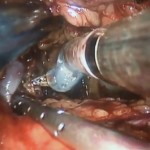Clinical and sonographic features predict testicular torsion in children: a prospective study
Sir,
We read the recent publication on clinical and sonographic features predicting testicular torsion in children with great interest [1]. Boettcher et al. identified a variety of clinical predictors, such as short pain duration, nausea or vomiting, abnormal ipsilateral cremasteric reflex, scrotal skin changes and high position of the testicle, as being associated with an increased likelihood of testiscular torsion. They showed that a clinical scoring system based on these clinical factors would have identified all cases of testicular torsion and would have reduced the negative exploration rate by 55%, and concluded that a reliable torsion diagnosis could not be obtained based on ultrasonography alone.
The authors are to be congratulated for their study, because they have identified important clinical variables for predicting testicular torsion and developed a simple and quick scoring system that will reduce the number of patients with acute scrotum undergoing scrotal exploration. We know that colour Doppler sonography (CDS) is the imaging method of choice for the evaluation of acute scrotum, with 63.6–100% sensitivity and 97–100% specificity [2,3]; however, it can show a misleading arterial flow in the early phases of torsion [3]. Furthermore, this imaging technique is operator-dependent and can be difficult to perform in prepubertal children. Other imaging methods, such as scintigraphy and dynamic MRI of the scrotum, provide a sensitivity and specificity similar to that of CDS [3], but these techniques are time-consuming and may also delay diagnosis. Differential diagnosis of testiscular torsion, therefore, remains a clinical diagnosis, and clinical variables such as short duration of pain, nausea and vomiting, high position of testis, skin changes and abnormal ipsilateral cremasteric reflex, deserve to play a more important role in surgical decision-making [4,5].
We believe that CDS, if performed correctly with modern equipment, is an important examination device for the assessment of children with acute scrotum; however, information from CDS should be supported by clinical findings and a physical examination of the patients. A clinical scoring system combined with CDS would be helpful for patient evaluation and to avoid unnecessary scrotal explorations.
Mustafa Resorlu, Yusuf Ziya Tan*, Fatma Uysal, Murat Tolga Gulpinar†, Gurhan Adam and Huseyin Ozdemir
Departments of Radiology, *Nuclear Medicine and †Urology, Faculty of Medicine, Canakkale Onsekiz Mart University, Canakkale, Turkey
References
- Boettcher M, Krebs T, Bergholz R, Wenke K, Aronson D. Clinical and sonographic features predict testicular torsion in children: a prospective study. BJU Int 2013 [Epub ahead of print], doi:10.1111/bju.12229.
- Kalfa N, Veyrac C, Lopez M et al. Multicenter assessment of ultrasound of the spermatic cord in children with acute scrotum. J Urol 2007; 177: 297-301.
- Tekgül S, Riedmiller H, Dogan HS et al. EAU Guidelines on paediatric urology p17, 2013. Available at: https://www.uroweb.org/gls/pdf/22%20Paediatric%20Urology_LR.pdf.
- Ciftci AO, Senocak ME, Tanyel FC et al. Clinical predictors for differential diagnosis of acute scrotum. Eur J Pediatr Surg 2004; 14: 333-8.
- Beni-Israel T, Goldman M, Bar Chaim S, Kozer E. Clinical predictors for testicular torsion as seen in the pediatric ED. Am J Emerg Med 2010; 28: 786-9.


Sir,
We read the letter to the editor regarding our article with great interest [1]. We share the assessment of Resorlu et al. that history, clinical examination and imaging should be in accordance. The goal of diagnosis is to identify boys with testicular torsion as soon as possible to shorten the duration of ischemia; ultimately to improve salvage rate. Several studies have concentrated on correct diagnosis to lower the incidence of unnecessary surgery without losing a testis due to undetected torsion. However, most of the scores developed for children include clinical, yet no imaging factors [1, 2]. Depending on the cut-off, these scores offer high sensitivity of up to 100% and with acceptable specificity. At higher cut-offs with 100% specificity they may allow to skip ultrasound and to reduce time until surgical detorsion.
Nevertheless, it is surprising that ultrasound has not been part of these scores. It offers good accessibility, rapidity, non-invasiveness, without the associated risk of ionizing radiation and capacity to show anatomic details valuable for differential diagnosis. For instance a multicentric study from eleven European university hospitals reported a sensitivity of 96% and specificity of 99% to diagnose testicular torsion [3]. We strongly believe that the application of suitable ultrasound signs like proposed by Chmelnik et al. will improve diagnostic certainty and might further reduce negative surgical exploration rate – at least in the right hands [1, 4]. Thus additional prospective studies evaluating score that comprise clinical and imaging predictors of testicular torsion are needed.
Michael Boettcher
On behalf of the authors
References